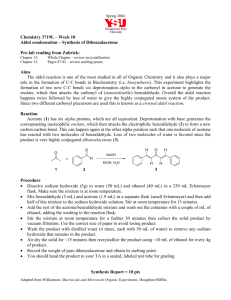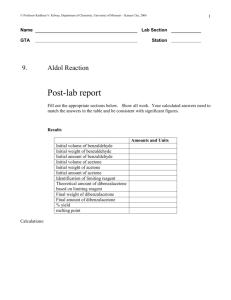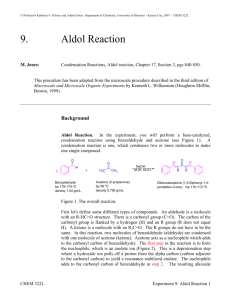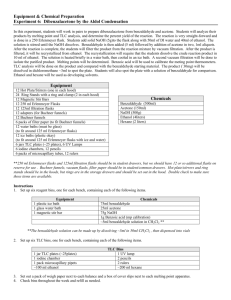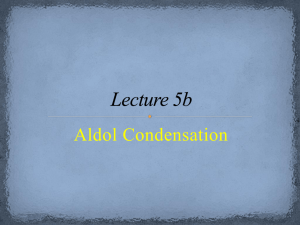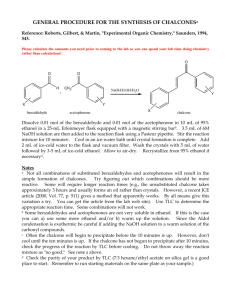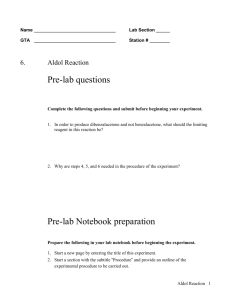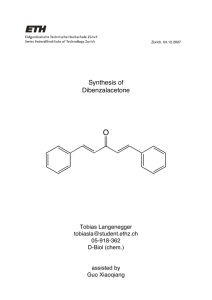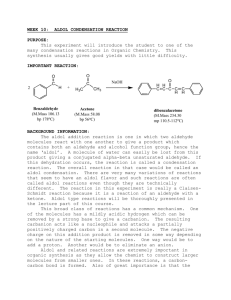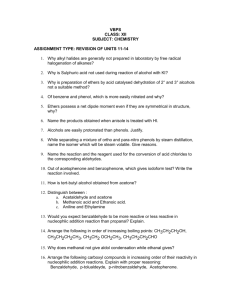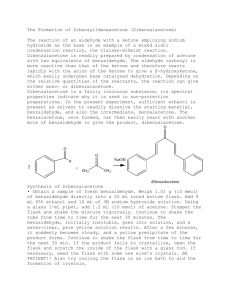Aldol Condensation Lab: Dibenzalacetone Synthesis
advertisement
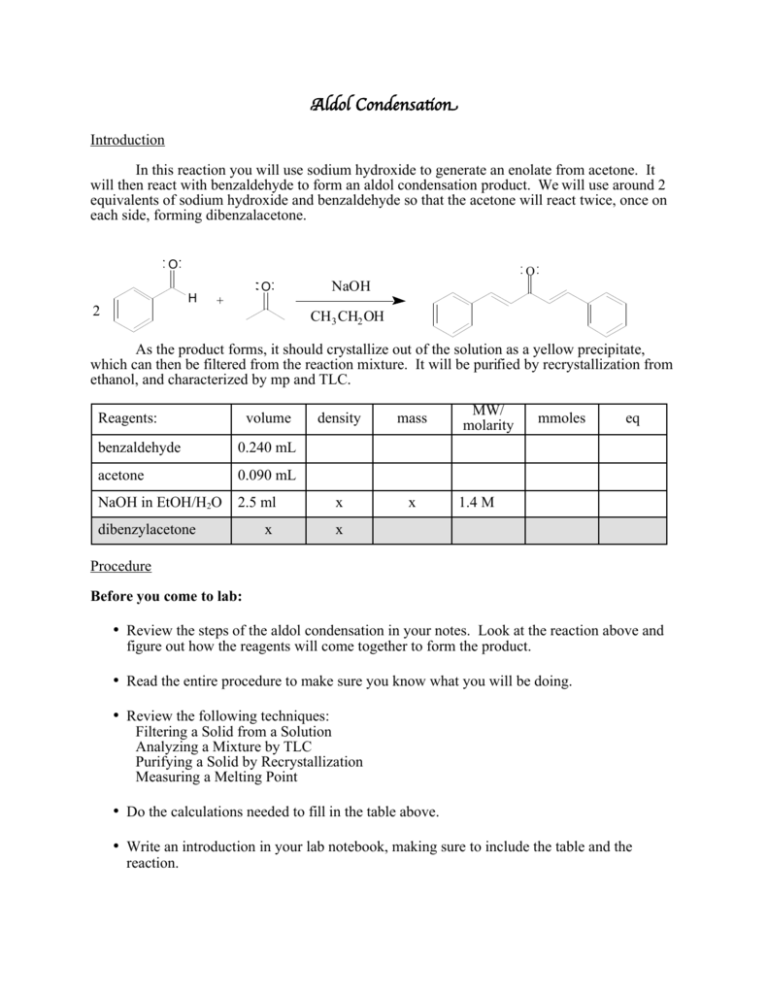
Aldol Condensaton Introduction In this reaction you will use sodium hydroxide to generate an enolate from acetone. It will then react with benzaldehyde to form an aldol condensation product. We will use around 2 equivalents of sodium hydroxide and benzaldehyde so that the acetone will react twice, once on each side, forming dibenzalacetone. O O H 2 NaOH O + CH 3 CH2 OH As the product forms, it should crystallize out of the solution as a yellow precipitate, which can then be filtered from the reaction mixture. It will be purified by recrystallization from ethanol, and characterized by mp and TLC. Reagents: volume density mass x benzaldehyde 0.240 mL acetone 0.090 mL NaOH in EtOH/H2O 2.5 ml x x x dibenzylacetone MW/ molarity mmoles eq 1.4 M Procedure Before you come to lab: • Review the steps of the aldol condensation in your notes. Look at the reaction above and figure out how the reagents will come together to form the product. • Read the entire procedure to make sure you know what you will be doing. • Review the following techniques: Filtering a Solid from a Solution Analyzing a Mixture by TLC Purifying a Solid by Recrystallization Measuring a Melting Point • Do the calculations needed to fill in the table above. • Write an introduction in your lab notebook, making sure to include the table and the reaction. • Do the on-line pre-lab questions. During lab: Set up and run the reaction: • Add the benzaldehyde, acetone, and NaOH catalyst solution to a 5 ml conical vial with a spin vane. Use a syringe to dispense the benzaldehyde so that you don’t let oxygen into the bottle. • Stir the reaction for 30 minutes at room temp (uncovered). Observe what occurs as the reaction progresses. Isolate the product from the reaction mixture: • If a solid has formed, filter it from the solution. If an oil forms instead, cool it in ice and stir vigorously with a spatula until it forms a solid, then filter it. • Place 2 ml of 5% acetic acid in ethanol (this solution is already prepared for you) into an ice bath to chill it. Transfer the crystals to a 10 ml beaker, add the acetic acid solution, and stir them together to remove all traces of NaOH. Be sure to break up any clumps. • Filter the crystals again (make sure to wash out your filter flask first!). With the vacuum running, add about 10 drops of cold ethanol to wash out any remaining acetic acid. Purify the product: • Recrystallize the product from ethanol, following the procedure for recrystallization. Use a clean 10 ml beaker to form the crystals. • After you have filtered the crystals, let them dry for 2-5 min on a watch glass on a hot plate at low heat. This evaporates off the remaining ethanol, which would interfere with measuring the mass and melting point. Characterize the product: • Observe the appearance of the product. Authentic dibenzylacetone is a yellow crystalline solid. • Obtain the mass of the crystals and calculate the % yield. Average student yield is 48%. • Perform a TLC analysis to check the purity of the product. Use 10% ethyl acetate in hexanes as the eluting solvent. (Prepare a solution in your TLC vial.) • Take the melting point of the product and compare it to the literature value (110oC). • Your conclusion should discuss the appearance of the product, the mass and % yield you obtained, the TLC data purity, and your melting point, how close it is to the literature value, and its range. Questions for Aldol Reaction Name: _______________________ 1) Draw the mechanism for this reaction. You can abbreviate the addition of the second benzaldehyde if you should the first one completely. 2) This reaction is an example of a mixed aldol condensation. Why is only one product formed? 3) Draw the product that would have resulted if: a) cyclohexanone had been used instead of acetone b) 2,2-dimethylpropanal had been used instead of benzaldehyde (heat may have been required in this case) 4) Explain why the NaOH is a catalyst in this reaction, rather than a reagent. (Hint - look at the reaction mechanism.) 5) Usually an aldol condensation must be heated in order to dehydrate the beta-hydroxy ketone to form the C=C. What is different about this product that causes it to dehydrate at room temperature? 6) How does the precipitation of the product from the reaction mixture help create more product? (hint – how does it affect the equilibrium) 7) What type of isomers could result from this reaction? b) How would the melting point give you an idea of whether isomers are present? 8) Look at the equivalents of the reagents used in this reaction. a) Why is benzaldehyde the limiting reagent in this case even though there are more equivalents used than acetone? b) How does this affect the equivalents of product? 9) Why does this product have a yellow color?
